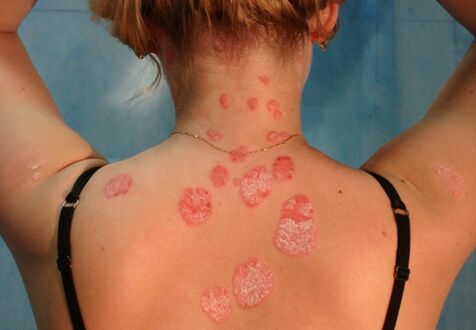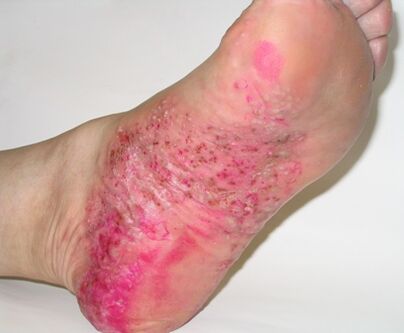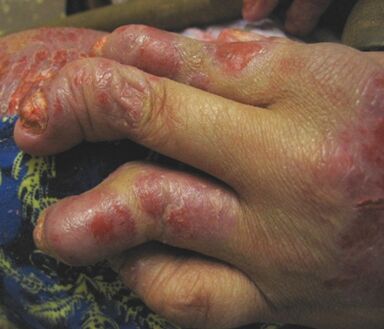According to the WHO, currently 2-4% of the world's population suffers from psoriasis. The disease affects patients of all ages, however, most often young people (15-25 years). Unfortunately, today’s medications cannot completely cure psoriasis, but timely professional treatment improves the quality of life. Therefore, if able to detect the first symptoms, it is better to see a doctor immediately.
Psoriasis- This is a dermatosis, which manifests itself in the form of scaly papules on the skin. Its specialty is that, in addition to the skin, it is able to affect the joints and nail plates. In the pathogenesis of psoriasis, hereditary factors are clearly detected, and other irritants are only secondary causes of its occurrence.
During the exacerbation of the disease, the process of natural formation is disrupted - keratinocytes (cells made up of human skin). There are also biochemical changes in the skin. In addition, recently, doctors were able to prove that during the acute phase of the disease, the function of the nervous system also differs from the norm. In general, the main reason for the appearance of psoriasis is the presence of damage in the function of the immune system.
The spread of psoriasis
Psoriasis is common. Currently, the incident statistics are as follows:
- China - 0. 3%;
- USA - 1%;
- Denmark - 1-2. 3%;
- Northern Europe - 3%;
- Germany - 1-1. 3%.
Curious that the native population of South America is not affected by the disease. At least no such cases have been reported so far. If you look at the condition as a whole, then the proportion of psoriasis is around 6-8% of all skin diseases.
As already mentioned, psoriasis manifests itself at any age, but often young people (up to 25 years old) still suffer from it, and in men and women, it occurs with equal frequency.
Epidemiological conditions
Based on its cause, psoriasis is a non -communicable disease with a significant genetic predisposition. Those most at risk of falling ill are those whose relatives also suffer from the disease (in this case, only close relatives are meant). European researchers have proven with certainty that if one of the parents is ill, then he has a 14-25% chance of transmitting it to his child. If both parents are ill, this probability is already 41-60%.
According to the type of development of the disease, psoriasis is divided into two groups:
- early;
- through.
This is evidence that there are two main types of psoriasis (such as diabetes mellitus). The first occurs in humans at an early age (average 16–22 years), is hereditary and directly related to the HLA (HLA-Cw6) phenotype. The course of the disease is often severe and over time the disease only progresses.
The cause of type II psoriasis is quite random, so the disease is sporadic. It occurs most often in the elderly (around 60 years of age). In general, it runs easily, however, in some cases, it can be exacerbated by damage to the joints and nails.
Factors that give rise to the appearance of psoriasis
Although psoriasis tends to be inherited, it is usually multifactorial in nature. Anything can trigger potentially fatal damage to the immune system. Thus, provoking factors are divided into external and internal (or, scientifically, exogenous and endogenous).
Exogenous factors

They are further divided into physical and chemical. The first includes mechanical damage to the skin, such as household injuries, heat wounds, abrasions, scars, tattoos, scratches, insect and pet bites. Cases of psoriasis at the injection site have also been recorded. X-ray and ultraviolet irradiation also play an important role. In about 5% of cases, the disease occurs in the summer, and 40% of it is caused by sunburn.
Chemical factors are expressed in the toxic effects of harmful chemicals or other irritants on the skin. In addition, psoriasis is also provoked by other skin diseases, such as:
- dermatosis;
- fungal infections;
- infectious impetigo;
- acne;
- dyshidrosis;
- moss;
- herpes zoster;
- pyoderma gangrene;
- allergic dermatitis of various natures.
There are cases of the disease known after performing a basic diagnostic skin test to find out the body’s reaction to cosmetics, hygiene products, formalin, chromium, nickel and other chemicals.
Endogenous factors
The internal cause of psoriasis can be an infectious disease. Recent research in this area suggests that streptococcal and HIV infections are most likely to blame. Moreover, often symptoms do not appear during the disease itself, but even after regular vaccination. In these cases, psoriasis is often difficult to treat.
To induce remission, lithium preparations, beta-blockers, nonsteroidal anti-inflammatory drugs, and ACE inhibitors were used. Corticosteroids are contraindicated in this case.
Pregnancy and childbirth
Significant changes in hormone levels caused by pregnancy can also be a provoking factor. A similar pattern is also observed during puberty. Also curious that women who already have psoriasis may experience an improvement in their condition during pregnancy (40%). Deterioration is much more rare (only in 14% of cases). True, after giving birth in most patients, the condition worsens (in 54% of cases)
Diet and nutrition
These factors often do not have a significant impact on the course of the disease. It is only known that alcohol and cigarette abuse significantly increases the likelihood of developing psoriasis and exacerbates its course.
Hypocalcemia and hypokalemia
These factors can provoke the appearance of pustular psoriasis in general. The chances of a good outcome in this case are very small.

Pustular psoriasis.
Psychogenic factors
Their role today is considered quite controversial. A number of researchers claim that the presence of traumatic psychogenic factors provokes psoriasis in 60% of all cases. However, it is only known that they can only exacerbate the course of the disease and reduce the effectiveness of therapy.
Welding
Currently, several separate types of psoriasis have been identified. They differ in the clinical picture and the degree of its effect on the body, therefore, to get an idea of †‹вЂ‹ what is at stake, it is better to look at the World Wide Web and carefully study the photos of psoriasis of various etiologies, as well as get acquainted with the description.
Strange psoriasis
Severe or common psoriasis occurs in most cases. The disease manifests itself as a rash of numerous bright red papules (from match heads to nuts). Once they appear, they grow rapidly, and silvery white scales appear on their surface. In the future, the papule turns into a plaque, which merges into one large lesion. Often they have clear boundaries that separate them from healthy skin.
When you try to comb or remove a papule, the exfoliation first increases. This phenomenon is known as "stearin spot symptoms", and once all the scales are removed, a shiny and smooth surface, "terminal film symptoms" can be found. If you continue to scrape, the capillaries are injured and droplets of blood are released. This symptom is known as "blood dew".
The development of psoriasis is divided into three main periods:
- progressive (acute);
- pegun;
- settlement period.
The success of treatment here depends on how accurately the method of therapy is chosen, because, depending on its duration, its effectiveness varies.

Growing period. The hallmark of this stage is the appearance of a specific rash. In the exacerbation phase, certain parts of the patient’s body are covered with small papules, which actively exfoliate. Peeling in this case is tightly localized and does not affect healthy skin. It is very easy to identify acute psoriasis with red or pink border features that limit papules.
The most noticeable symptoms at this stage are itching and the presence of symptoms called Koebner’s. The latter is stated in the fact that psoriatic papules appear at the site of skin injury (small burns, scratches, injections, scratches, etc. ). This phenomenon occurs on average two weeks after the injury itself and occurs in 38-76% of all patients.
It is also very strange that (more rarely) the opposite effect is also observed. Scientists believe that it is due to the presence in the blood serum of some patients special factors that prevent Koebner syndrome.
Stationary period. On average, 2-3 months after the appearance of the first rash, the formation of new papules stops. Plaque growth also stopped. At this stage, their entire surface is already covered with scales. This period can last for months or even years. However, the latter is relatively rare.
Settlement period. This period is also called the regressive period, because a gradual decrease in plaque is observed during that time. At first, they stop peeling, and then they slowly smooth out until they disappear completely. If the disease is mild, this phenomenon occurs spontaneously. Treatment only speeds up its onset. Often, the place where the plaque is located stands out against the background of healthy skin areas by way of depigmentation or, which occurs relatively rarely, by hyperpigmentation. With psoriasis vulgaris, the rash can occur almost anywhere, and is usually localized symmetrically (the extensor surfaces of the elbow and knee). Can also appear on the head, sacrum, hands, palms, soles of the feet, groin and armpits. Moreover, in many cases, the nail plate is also affected (appearance of puncture holes, loosening, thickening). These symptoms are very similar to those that appear when infected with a fungus, so that a final diagnosis is made only after receiving a negative reaction to fungal spores in specialized laboratory studies. Psoriasis vulgaris as a whole does not have a general negative effect on the patient's body, and its course is chronic. Periods of exacerbation occur in autumn or winter, while in summer exacerbations, on the other hand, are much rarer. The main incentive for active treatment lies in the fact that without appropriate therapy, psoriatic plaques can cover the body for years, while adequate treatment leads to improvement after a few months.
Psoriatic erythroderma
Psoriatic erythroderma is one of the most unpleasant forms of this disease. On average, similar reactions are observed in about 2% of patients and they occur spontaneously and as a result of improperly chosen treatment. Although, of course, if the medication used irritates the skin or is exposed to ultraviolet radiation, the risk of psoriatic erythroderma is much higher. Often, psoriatic erythroderma appears suddenly during the first stage of psoriasis. It can be combined with arthritis and general pustular psoriasis, and exposure to factors such as streptococcal infection or hypocalcemia significantly increases the likelihood of such complications. Sudden intake of corticosteroids can also worsen the condition. The appearance of erythroderm completely eliminates the clinical symptoms of psoriasis, which is replaced by diffuse redness of the skin, severe itching and exfoliation of the lamellae.
Pustular psoriasis
Also severe forms of psoriasis. It is characterized by the appearance of abscesses, which are often the only symptoms. More rarely it is combined with the classic symptoms of psoriasis vulgaris. Pustular psoriasis is generalized and localized. The latter differs only in that the abscess in this case is only concentrated in the area of the palms or soles of the feet.
Psoriatic arthritis
Currently, psoriatic arthritis is classified as an autoimmune disease in itself. It is expressed as damage to bones and muscles in patients who already have psoriasis or have a high risk of the disease from a family history. Often psoriatic arthritis is combined with classic psoriasis, as well as psoriatic nail lesions. The disease is diagnosed with the occurrence of back pain, accompanied by the following conditions:
- lack of a clear reason for appearance;
- patient age over 40;
- unexplained deep pain in the lower back or buttocks;
- unclear localization of pain;
- pain reduction after exercise;
- pain or cramping felt in the early morning or at night;
- the presence of pain with an excellent general condition of the musculoskeletal system.
Psoriasis of the nail plate
Often, psoriasis vulgaris is accompanied by nail damage. In this case, their significant dystrophy is observed, as well as characteristic symptoms of fungal infections. It is a companion of psoriatic arthritis. Given that about 4% of the world’s population suffers from common psoriasis, then 30-50% of them also have nail psoriasis.
Psoriasis treatment
Unfortunately, at present, drugs are still unable to cure psoriasis, as this requires a deeper knowledge of the specificity of the work of the basic mechanisms of the human immune system. Because this type of research is progressing relatively slowly, and the disease itself does not pose a particular threat to life, symptomatic therapy is currently a priority. Before starting treatment, patients need a thorough examination, because each organism contains a group of individual factors that influence the course of the disease. Gender, age, profession, general health, type of psoriasis - all of these must be taken into account when prescribing therapeutic therapy. An important role is also played by the formation of the nature of the disease, the susceptibility of individuals to drugs and the extent of the disease.
General activities
First of all, the doctor needs to determine the mental and physical condition of the patient, assess the general condition of his body and find out how tolerant he is to the disease. The best prerequisites for effective treatment are good rest, living in a quiet environment, switching to a less intensive mode of work, or being admitted to a short -term hospitalization. Various methods of psychotherapy (rehabilitation in marine resorts with the use of cognitive behavioral therapy, etc. ) also prove themselves quite good. It is also important for patients to know that the healing process is going as it should, because, without getting a quick effect, about 40% of patients lose faith in the effectiveness of therapy and begin to ignore it. It is important not to forget that psoriasis is a chronic disease, therefore the safety of therapy must be taken into account. Many drugs are toxic and can accumulate in the body, turning into time bombs. Addictive effects are also possible, so it’s best to keep the most potent medication until really dangerous symptoms appear.
Disease course and long -term prognosis
The course of psoriasis is often unpredictable. Modern doctors are practically unsuccessful in this regard, therefore, as before, psoriasis remains an unpleasant and uncontrollable disease. In each case, this process is performed individually, so that any attempt to make a prognosis of the course of the disease, as well as the duration of the phases of enlargement and remission, will inevitably fail. Just one pleasant thing - although difficult to undergo treatment, it rarely poses a real threat to a patient’s life. For psoriatic arthritis, the disease is much simpler than rheumatoid arthritis, and the decline in the patient’s quality of life, compared with the latter, is highly insignificant. Statistics show that with proper treatment, most patients with psoriatic arthritis remain functional and are able to live fulfilling lives. If the necessary therapy is not present, or the disease persists with complications, joint deformity can develop with the development of more severe pathology. However, such complications are only present in a small number of patients with psoriasis. A large number of patients can rely on the gradual stabilization of the condition and the emergence of long-term remission (more than two years). In very rare cases, the disease persists in the active phase, however, in these cases, the disease can be effectively localized. Effective treatments for psoriasis today can be found in any major city. And, as you know, the final recovery is not achievable, diet, medications and special procedures will quickly do its job. You also do not need long -term hospital treatment. The doctor's job is simply to quickly get through the first two stages of psoriasis and bring the person into recovery. After that, the patient can only take care of himself, follow the instructions and forget about the disease for a long time.























